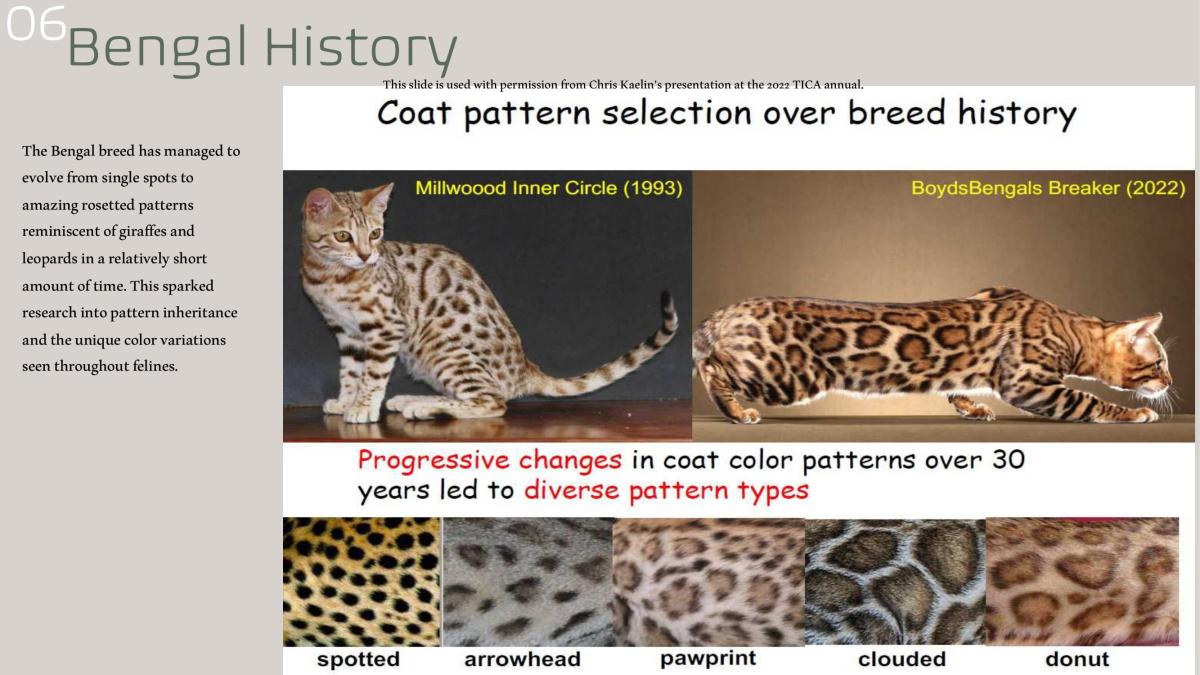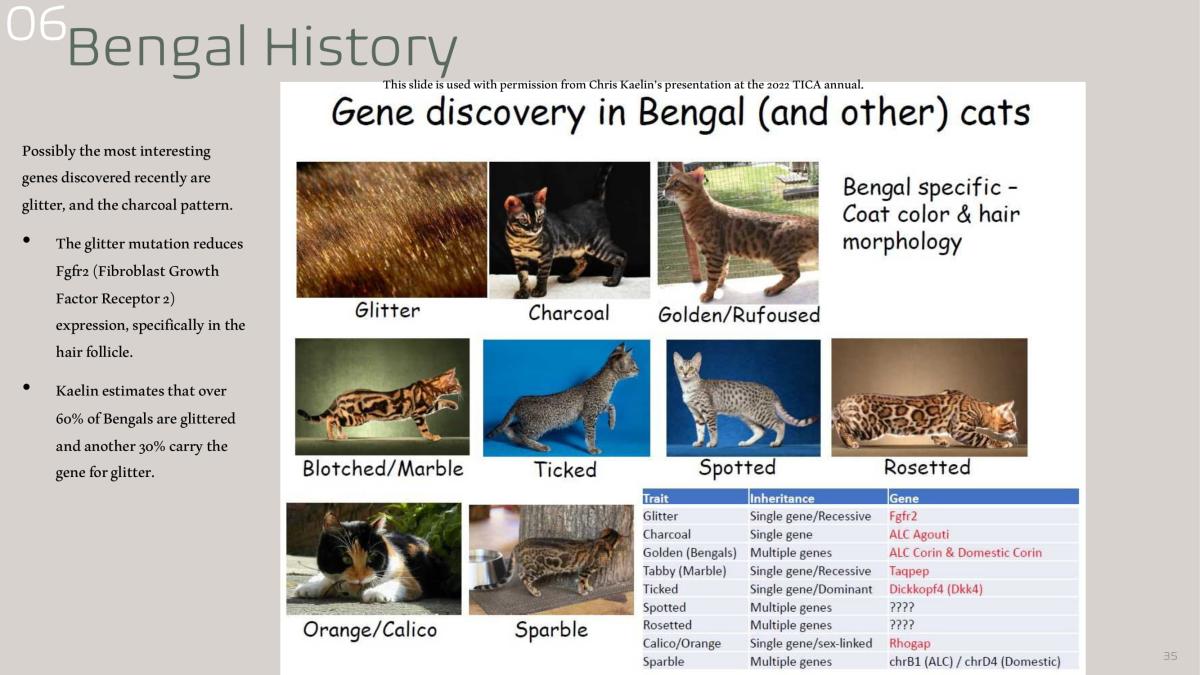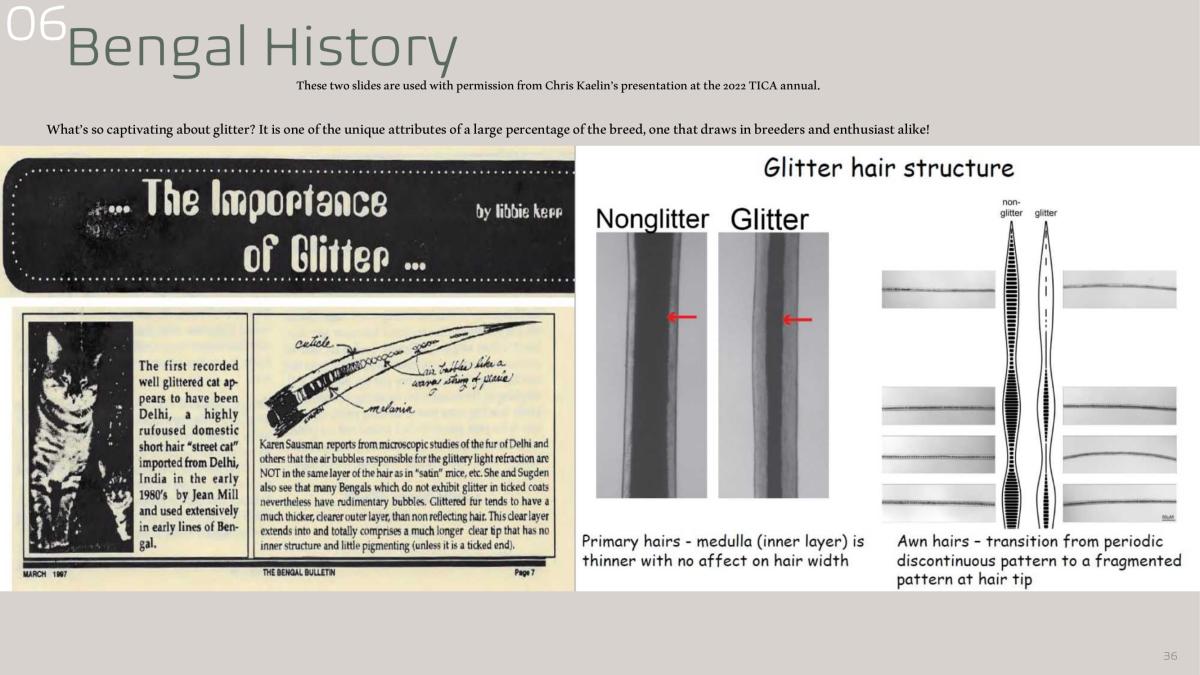The Bengal breed has managed to evolve from single spots to amazing rosetted patterns reminiscent of giraffes and leopards in a relatively short amount of time.

The Bengal Timeline
1961
Jean Mill imports an ALC female. Later, in 1963, she crosses it with a solid black DSH male. The project is abandoned when Mill is widowed.
1980
Dr. Willard Centerwall, who was researching the ALC's possible natural immunity to Feline Leukemia gives Mill the F1 hybrids that are the foundation of the breed as we know it.
1982
Millwood Tory of Delhi is imported for
from India, introduces the gene glitter into the breed. His sister, Tasha was imported at the same time and although not glittered, she likely carried the gene.
1985
Mill began showing her Bengals in the new breed category of TICA, later her 2nd generation queen Penny Ante captivated audiences with her friendly temperament. Also in 1985, CFA retracted Mill's Indian Mau registrations as the pressure mounted against her wild hybrids.
1987
A new kind of Bengal is born,
the marble pattern... Mill credits these cats with contributing the 'outlining gene' and the first rosettes were born from descendants.
1992
TICA acceptance:
TICA admitted the breed into championship status, cats four generations removed from outcrosses are considered domestic and able to be shown.
1990s
After official recognition the Bengal breed is the fastest growing breed over the next decade.
1993
Marble Bengals were accepted into TICA and the snows/seal series in the subsequent years
2016
Accepted for Miscellaneous Status in CFA. Cats must be 6 generations removed to be eligible for registration and exhibition.
2018
Bengals accepted in CFA. After 1 year in the Miscellaneous class, CFA's executive board votes to accept Bengals as a Championship breed in CFA.

Bengal History
The Bengal breed has managed to evolve from single spots to amazing rosetted patterns reminiscent of giraffes and leopards in a relatively short amount of time. This sparked research into pattern inheritance and the unique color variations seen throughout felines.
Coat pattern selection over breed history
- Millwoood Inner Circle (1993)
- Boyds Bengals Breaker (2022)
Progressive changes in coat color patterns over 30 years led to diverse pattern types
- spotted
- arrowhead
- pawprint
- clouded
- donut

Bengal History
Possibly the most interesting genes discovered recently are glitter, and the charcoal pattern.
- The glitter mutation reduces Fgfr2 (Fibroblast Growth Factor Receptor 2) expression, specifically in the hair follicle.
- Kaelin estimates that over 60% of Bengals are glittered and another 30% carry the gene for glitter.
Gene discovery in Bengal (and other) cats
Bengal specific - Coat color & hair morphology
- Glitter
- Charcoal
- Golden/Rufoused
- Blotched/Marble
- Ticked
- Spotted
- Rosetted
- Orange/Calico
- Sparble

Bengal History
What's so captivating about glitter? It is one of the unique attributes of a large percentage of the breed, one that draws in breeders and enthusiast alike!
The Importance of Glitter ...by libbie kepp
The first recorded well glittered cat ap- pears to have been Delhi, a highly rufoused domestic short hair "street cat" imported from Delhi, India in the early 1980's by Jean Mill and used extensively in early lines of Bengal.
Karen Sausman reports from microscopic studies of the fur of Delhi and others that the air bubbles responsible for the glittery light refraction are NOT in the same layer of the hair as in "satin" mice, etc. She and Sugden also see that many Bengals which do not exhibit glitter in ticked coats nevertheless have rudimentary bubbles. Glittered fur tends to have a much thicker, clearer outer layer, than non reflecting hair. This clear layer extends into and totally comprises a much longer clear tip that has no inner structure and little pigmenting (unless it is a ticked end).
Glitter hair structure
- Primary hairs - medulla (inner layer) is thinner with no affect on hair width
- Awn hairs - transition from periodic discontinuous pattern to a fragmented pattern at hair tip
Acknowledgements and Full Credits to: https://cfa-files.s3.us-east-2.amazonaws.com/breed-presentations/Bengal.pdf
